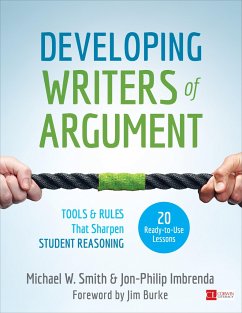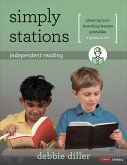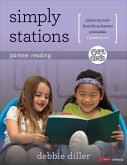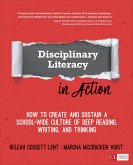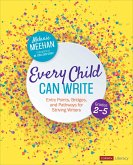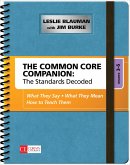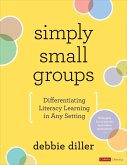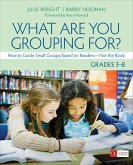Michael W. Smith, Jon-Philip Imbrenda
Developing Writers of Argument
Tools and Rules That Sharpen Student Reasoning
Michael W. Smith, Jon-Philip Imbrenda
Developing Writers of Argument
Tools and Rules That Sharpen Student Reasoning
- Broschiertes Buch
- Merkliste
- Auf die Merkliste
- Bewerten Bewerten
- Teilen
- Produkt teilen
- Produkterinnerung
- Produkterinnerung
Forming effective arguments is essential to students' success in academics and in life. This book's engaging lessons offer an innovative approach to teaching this critical and transferable skill.
Andere Kunden interessierten sich auch für
![Simply Stations: Independent Reading, Grades K-4 Simply Stations: Independent Reading, Grades K-4]() Debbie DillerSimply Stations: Independent Reading, Grades K-430,99 €
Debbie DillerSimply Stations: Independent Reading, Grades K-430,99 €![Simply Stations: Partner Reading, Grades K-4 Simply Stations: Partner Reading, Grades K-4]() Debbie DillerSimply Stations: Partner Reading, Grades K-424,99 €
Debbie DillerSimply Stations: Partner Reading, Grades K-424,99 €![Disciplinary Literacy in Action Disciplinary Literacy in Action]() ReLeah Cossett Lent (ReLeah Lent Educational Consulting)Disciplinary Literacy in Action39,99 €
ReLeah Cossett Lent (ReLeah Lent Educational Consulting)Disciplinary Literacy in Action39,99 €![Every Child Can Write, Grades 2-5 Every Child Can Write, Grades 2-5]() Melanie Meehan (Simsbury Public Schools)Every Child Can Write, Grades 2-533,99 €
Melanie Meehan (Simsbury Public Schools)Every Child Can Write, Grades 2-533,99 €![The Common Core Companion: The Standards Decoded, Grades 3-5 The Common Core Companion: The Standards Decoded, Grades 3-5]() Leslie A. BlaumanThe Common Core Companion: The Standards Decoded, Grades 3-546,99 €
Leslie A. BlaumanThe Common Core Companion: The Standards Decoded, Grades 3-546,99 €![Simply Small Groups Simply Small Groups]() Debbie DillerSimply Small Groups26,99 €
Debbie DillerSimply Small Groups26,99 €![What Are You Grouping For?, Grades 3-8 What Are You Grouping For?, Grades 3-8]() Julie T. Wright (Consultant)What Are You Grouping For?, Grades 3-845,99 €
Julie T. Wright (Consultant)What Are You Grouping For?, Grades 3-845,99 €-
-
-
Forming effective arguments is essential to students' success in academics and in life. This book's engaging lessons offer an innovative approach to teaching this critical and transferable skill.
Produktdetails
- Produktdetails
- Corwin Literacy
- Verlag: SAGE Publications Inc
- Seitenzahl: 184
- Erscheinungstermin: 6. Februar 2018
- Englisch
- Abmessung: 277mm x 216mm x 15mm
- Gewicht: 524g
- ISBN-13: 9781506354330
- ISBN-10: 1506354335
- Artikelnr.: 50103669
- Herstellerkennzeichnung
- Libri GmbH
- Europaallee 1
- 36244 Bad Hersfeld
- gpsr@libri.de
- Corwin Literacy
- Verlag: SAGE Publications Inc
- Seitenzahl: 184
- Erscheinungstermin: 6. Februar 2018
- Englisch
- Abmessung: 277mm x 216mm x 15mm
- Gewicht: 524g
- ISBN-13: 9781506354330
- ISBN-10: 1506354335
- Artikelnr.: 50103669
- Herstellerkennzeichnung
- Libri GmbH
- Europaallee 1
- 36244 Bad Hersfeld
- gpsr@libri.de
Michael W. Smith, a professor in Temple University¿s College of Education, joined the ranks of college teachers after eleven years of teaching high school English. His research focuses on understanding both how adolescents and adults engage with texts outside school and how teachers can use those understandings to devise more motivating and effective instruction inside schools.
Foreword by Jim Burke
Acknowledgments
PART I. THE ARGUMENT FOR ARGUMENT
Chapter 1. Introduction
Argument Cultivates Critical Thinking
Argument Fosters Collaborative Reasoning
Argument Promotes a Sense of Social Responsibility
What This Book Can Offer
Chapter 2. A Classroom Culture of Argumentation
Revisiting the Three R's
Conversation as a Metaphor for Learning
Staging Conversations in Your Classroom
So What, Exactly, Is an Argument, Anyway?
Chapter 3. Our Instructional Approach
Transferable Classroom Tools
So Do They Work?
PART II. LESSONS
Chapter 4. Everyday Arguments
Introducing the Elements of Argument
Lesson 1: Apple Music vs. Spotify
Lesson 2: Taco Bell vs. Chipotle
Lesson 3: Who Is the Better Superhero?
Lesson 4: Which Video Streaming Service Is the Best?
Lesson 5: Heinz's Dilemma
Lesson 6: To What Extent Am I Responsible to Others?
Chapter 5. Practicing Three Elements of Argument
Lesson 7: Crafting Controversial Claims
Lesson 8: What Makes an Effective Claim?
Lesson 9: What Makes Effective Data? Part 1
Lesson 10: What Makes Effective Data? Part 2
Lesson 11: How Do Warrants Relate to Claims and Data?
Lesson 12: Practice Writing Warrants
Chapter 6. Applying What They've Learned About Argument to Texts
Lesson 13: Who Is Going to Bounce Back?
Lesson 14: Using Three Key Questions to Understand a Poem
Lesson 15: Applying What We've Learned to a Literary Argument
Lesson 16: Learning the Reader's Rule of Rupture
Lesson 17: Applying Argumentative Strategies to Respond to a Well-Known
Theory
Lesson 18: Bringing Together All of the Elements of Argument: The Minnesota
Twins Study
Chapter 7. Putting It All Together: Applying Argument to Life Choices
Lesson 19: Should I Choose a 2-Year or 4-Year College?
Lesson 20: What Career Has the Best Potential for Me?
Chapter 8. How to Use This Book
Using the Lessons Directly
Using the Tools
Using Our Lessons as Templates
References
Index
Acknowledgments
PART I. THE ARGUMENT FOR ARGUMENT
Chapter 1. Introduction
Argument Cultivates Critical Thinking
Argument Fosters Collaborative Reasoning
Argument Promotes a Sense of Social Responsibility
What This Book Can Offer
Chapter 2. A Classroom Culture of Argumentation
Revisiting the Three R's
Conversation as a Metaphor for Learning
Staging Conversations in Your Classroom
So What, Exactly, Is an Argument, Anyway?
Chapter 3. Our Instructional Approach
Transferable Classroom Tools
So Do They Work?
PART II. LESSONS
Chapter 4. Everyday Arguments
Introducing the Elements of Argument
Lesson 1: Apple Music vs. Spotify
Lesson 2: Taco Bell vs. Chipotle
Lesson 3: Who Is the Better Superhero?
Lesson 4: Which Video Streaming Service Is the Best?
Lesson 5: Heinz's Dilemma
Lesson 6: To What Extent Am I Responsible to Others?
Chapter 5. Practicing Three Elements of Argument
Lesson 7: Crafting Controversial Claims
Lesson 8: What Makes an Effective Claim?
Lesson 9: What Makes Effective Data? Part 1
Lesson 10: What Makes Effective Data? Part 2
Lesson 11: How Do Warrants Relate to Claims and Data?
Lesson 12: Practice Writing Warrants
Chapter 6. Applying What They've Learned About Argument to Texts
Lesson 13: Who Is Going to Bounce Back?
Lesson 14: Using Three Key Questions to Understand a Poem
Lesson 15: Applying What We've Learned to a Literary Argument
Lesson 16: Learning the Reader's Rule of Rupture
Lesson 17: Applying Argumentative Strategies to Respond to a Well-Known
Theory
Lesson 18: Bringing Together All of the Elements of Argument: The Minnesota
Twins Study
Chapter 7. Putting It All Together: Applying Argument to Life Choices
Lesson 19: Should I Choose a 2-Year or 4-Year College?
Lesson 20: What Career Has the Best Potential for Me?
Chapter 8. How to Use This Book
Using the Lessons Directly
Using the Tools
Using Our Lessons as Templates
References
Index
Foreword by Jim Burke
Acknowledgments
PART I. THE ARGUMENT FOR ARGUMENT
Chapter 1. Introduction
Argument Cultivates Critical Thinking
Argument Fosters Collaborative Reasoning
Argument Promotes a Sense of Social Responsibility
What This Book Can Offer
Chapter 2. A Classroom Culture of Argumentation
Revisiting the Three R's
Conversation as a Metaphor for Learning
Staging Conversations in Your Classroom
So What, Exactly, Is an Argument, Anyway?
Chapter 3. Our Instructional Approach
Transferable Classroom Tools
So Do They Work?
PART II. LESSONS
Chapter 4. Everyday Arguments
Introducing the Elements of Argument
Lesson 1: Apple Music vs. Spotify
Lesson 2: Taco Bell vs. Chipotle
Lesson 3: Who Is the Better Superhero?
Lesson 4: Which Video Streaming Service Is the Best?
Lesson 5: Heinz's Dilemma
Lesson 6: To What Extent Am I Responsible to Others?
Chapter 5. Practicing Three Elements of Argument
Lesson 7: Crafting Controversial Claims
Lesson 8: What Makes an Effective Claim?
Lesson 9: What Makes Effective Data? Part 1
Lesson 10: What Makes Effective Data? Part 2
Lesson 11: How Do Warrants Relate to Claims and Data?
Lesson 12: Practice Writing Warrants
Chapter 6. Applying What They've Learned About Argument to Texts
Lesson 13: Who Is Going to Bounce Back?
Lesson 14: Using Three Key Questions to Understand a Poem
Lesson 15: Applying What We've Learned to a Literary Argument
Lesson 16: Learning the Reader's Rule of Rupture
Lesson 17: Applying Argumentative Strategies to Respond to a Well-Known
Theory
Lesson 18: Bringing Together All of the Elements of Argument: The Minnesota
Twins Study
Chapter 7. Putting It All Together: Applying Argument to Life Choices
Lesson 19: Should I Choose a 2-Year or 4-Year College?
Lesson 20: What Career Has the Best Potential for Me?
Chapter 8. How to Use This Book
Using the Lessons Directly
Using the Tools
Using Our Lessons as Templates
References
Index
Acknowledgments
PART I. THE ARGUMENT FOR ARGUMENT
Chapter 1. Introduction
Argument Cultivates Critical Thinking
Argument Fosters Collaborative Reasoning
Argument Promotes a Sense of Social Responsibility
What This Book Can Offer
Chapter 2. A Classroom Culture of Argumentation
Revisiting the Three R's
Conversation as a Metaphor for Learning
Staging Conversations in Your Classroom
So What, Exactly, Is an Argument, Anyway?
Chapter 3. Our Instructional Approach
Transferable Classroom Tools
So Do They Work?
PART II. LESSONS
Chapter 4. Everyday Arguments
Introducing the Elements of Argument
Lesson 1: Apple Music vs. Spotify
Lesson 2: Taco Bell vs. Chipotle
Lesson 3: Who Is the Better Superhero?
Lesson 4: Which Video Streaming Service Is the Best?
Lesson 5: Heinz's Dilemma
Lesson 6: To What Extent Am I Responsible to Others?
Chapter 5. Practicing Three Elements of Argument
Lesson 7: Crafting Controversial Claims
Lesson 8: What Makes an Effective Claim?
Lesson 9: What Makes Effective Data? Part 1
Lesson 10: What Makes Effective Data? Part 2
Lesson 11: How Do Warrants Relate to Claims and Data?
Lesson 12: Practice Writing Warrants
Chapter 6. Applying What They've Learned About Argument to Texts
Lesson 13: Who Is Going to Bounce Back?
Lesson 14: Using Three Key Questions to Understand a Poem
Lesson 15: Applying What We've Learned to a Literary Argument
Lesson 16: Learning the Reader's Rule of Rupture
Lesson 17: Applying Argumentative Strategies to Respond to a Well-Known
Theory
Lesson 18: Bringing Together All of the Elements of Argument: The Minnesota
Twins Study
Chapter 7. Putting It All Together: Applying Argument to Life Choices
Lesson 19: Should I Choose a 2-Year or 4-Year College?
Lesson 20: What Career Has the Best Potential for Me?
Chapter 8. How to Use This Book
Using the Lessons Directly
Using the Tools
Using Our Lessons as Templates
References
Index

